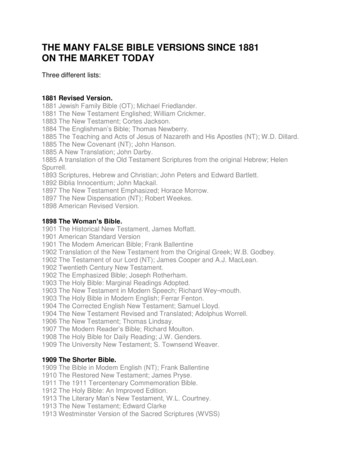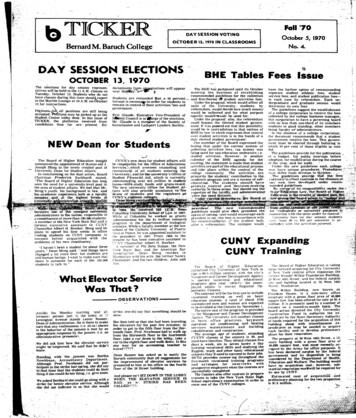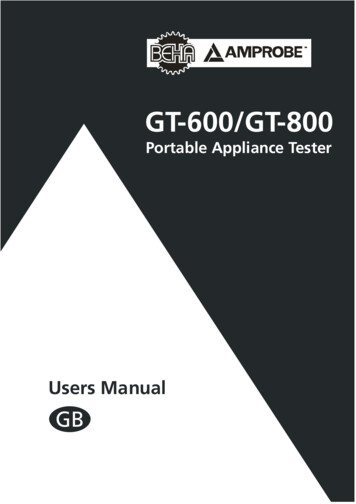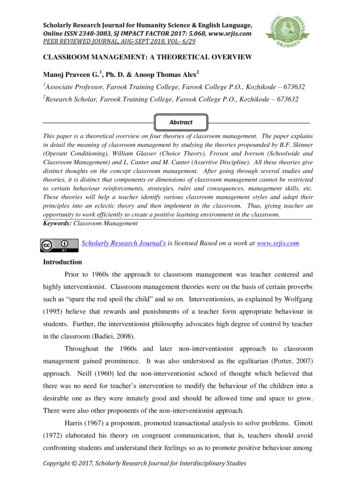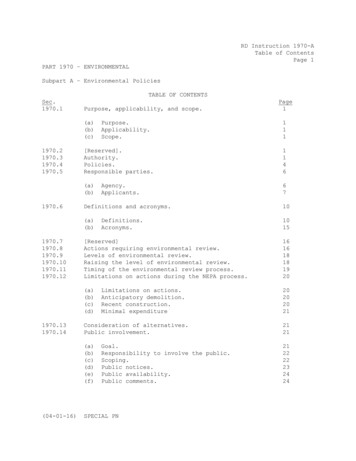
Transcription
RD Instruction 1970-ATable of ContentsPage 1PART 1970 – ENVIRONMENTALSubpart A – Environmental PoliciesTABLE OF CONTENTSSec.1970.1Purpose, applicability, and ved].Authority.Policies.Responsible parties.1146(a)(b)67Agency.Applicants.Definitions and d]Actions requiring environmental review.Levels of environmental review.Raising the level of environmental review.Timing of the environmental review process.Limitations on actions during the NEPA s on actions.Anticipatory demolition.Recent construction.Minimal expenditureConsideration of alternatives.Public .Responsibility to involve the public.Scoping.Public notices.Public availability.Public comments.SPECIAL PN
RD Instruction 1970-ATable of ContentsPage 2Sec.1970.151970.161970.171970.18PageInteragency cooperation.24(a) Coordination with other Federal agencies.(b) Adoption of documents prepared for or byother Federal agencies.(c) Cooperation with state and local governments.242425Mitigation.Programmatic analysis and tiering.Emergencies.262626(a)(b)(c)262727Urgent response.CE- and EA-level actions.EIS-level actions.1970.19 – 1970.50 [Reserved]Exhibits -ABCD-27Terms and acronymsDefinitions and acronyms for Electric and Telecom ProgramsEnvironmental Document ChecklistTemplatesAttachment 1: State Environmental Coordinator (SEC)Recommended Amendment to Position DescriptionAttachment 2: Appointment of a State EnvironmentalCoordinator or Assistant State EnvironmentalCoordinatorAttachment 3: Recommended Training Program forEnvironmental CoordinatorsE -Guide for and Principles of Effective Public Involvement(PI)Attachment 1: IAP2 spectrum tableF G H -Guide for Preparing an Environmental Resource DirectoryCoordination with Other Federal Agencies on FederallyDeclared Disaster Recovery: Unified Federal Review (UFR)Multi-tier agreementoOo
RD Instruction 1970-APART 1970 – ENVIRONMENTALSubpart A – Environmental Policies§ 1970.1Purpose, applicability, and scope.(a) Purpose. The purpose of this part is to ensure that the Agencycomplies with the National Environmental Policy Act of 1969, as amended(NEPA) (42 U.S.C. 4321, et seq.), and other applicable environmentalrequirements in order to make better decisions based on an understandingof the environmental consequences of proposed actions, and take actionsthat protect, restore, and enhance the quality of the human environment.(b) Applicability. The environmental policies and procedures containedin this part are applicable to programs administered by the RuralBusiness-Cooperative Service (RBS), Rural Housing Service (RHS), andRural Utilities Service (RUS); herein referred to as “the Agency.”(c) Scope. This part integrates NEPA with other planning,environmental review processes, and consultation procedures required byother Federal laws, regulations, and Executive Orders applicable toAgency programs. This part also supplements the Council onEnvironmental Quality (CEQ) regulations implementing the proceduralprovisions of NEPA, 40 CFR parts 1500 through 1508. To the extentappropriate, the Agency will take into account CEQ guidance andmemoranda. This part also incorporates and complies with the proceduresof Section 106 (36 CFR part 800) of the National Historic PreservationAct (NHPA) and Section 7 (50 CFR part 402) of the Endangered Species Act(ESA).§ 1970.2 [Reserved]§ 1970.3Authority.This part derives its authority from a number of statutes, ExecutiveOrders, and regulations, including but not limited to those listed in thissection. Both the Agency and the applicant, as appropriate, must comply withthese statutes, Executive Orders, and regulations, as well as any futurestatutes, Executive Orders, and regulations that affect the Agency’simplementation of this part.(a)National Environmental Policy Act of 1969 (42 U.S.C. 4321 et seq.);(b) Council on Environmental Quality Regulations Implementing theProcedural Provisions of the National Environmental Policy Act (40 CFRparts 1500 through 1508);(c) U. S. Department of Agriculture, NEPA Policies and Procedures (7CFR part 1b).DISTRIBUTION: WSALEnvironmental Policiesand Procedures1(04-01-16) SPECIAL PN
RD Instruction 1970-A§ 1970.3 (Con.)(d) Department of Agriculture, Enhancement, Protection, and Managementof the Cultural Environment (7 CFR parts 3100 through 3199);(e) Archaeological and Historic Preservation Act of 1960, as amended,(16 U.S.C. 469 et seq.);(f) Archaeological Resources Protection Act of 1979 (16 U.S.C. 470aa etseq.);(g)Bald and Golden Eagle Protection Act (16 U.S.C. 668 et seq.);(h)Clean Air Act (42 U.S.C. 7401 et seq.);(i) Clean Water Act (Federal Water Pollution Control Act, 33 U.S.C.1251 et seq.);(j)Coastal Barrier Resources Act (16 U.S.C. 3501 et seq.);(k)Coastal Barrier Improvement Act (42 U.S.C. 4028 et seq.);(l)Coastal Zone Management Act (16 U.S.C. 1456);(m) Comprehensive Environmental Response, Compensation, and LiabilityAct (42 U.S.C. 103) (CERCLA);(n) Consolidated Farm and Rural Development Act, Sections 307(a)(6)(A)(7 U.S.C. 1927(a)(6)(A)) and 363 (7 U.S.C. 2006e);(o)Endangered Species Act of 1973 (16 U.S.C. 1531 et seq.);(p)Farmland Protection Policy Act (7 U.S.C. 4201 et seq.);(q) Historic Sites, Buildings and Antiquities Act (16 U.S.C. 461 etseq.);(r) Housing and Community Development Act of 1992 (42 U.S.C.542(c)(9));(s)Migratory Bird Treaty Act (16 U.S.C. 703-711);(t)National Historic Preservation Act (16 U.S.C. 470 et seq.);(u)National Trails System Act (16 U.S.C. 1241 et seq.);(v) Native American Graves Protection and Repatriation Act (25 U.S.C.3001 et seq.);2
RD Instruction 1970-A§ 1970.3 (Con.)(w)Noise Control Act (42 U.S.C. 4901 et seq.);(x)Pollution Prevention Act of 1990 (42 U.S.C. 13101 et seq.);(y)Resource Conservation and Recovery Act (42 U.S.C. 6901);(z)Safe Drinking Water Act - (42 U.S.C. 300f et seq.);(aa)Wild and Scenic Rivers Act (16 U.S.C. 1271 et seq.);(bb)Wilderness Act (16 U.S.C. 1131 et seq.);(cc) Compact of Free Association between the United States and theRepublic of the Marshall Islands and between the United States and theFederated States of Micronesia (Public Law 108-188);(dd) Compact of Free Association between the United States and theRepublic of Palau (Public Law 99-658);(ee) Executive Order 11514, Protection and Enhancement of EnvironmentalQuality;(ff) Executive Order 11593, Protection and Enhancement of the CulturalEnvironment;(gg)Executive Order 11988, Floodplain Management;(hh)Executive Order 11990, Protection of Wetlands;(ii) Executive Order 12898, Federal Actions to Address EnvironmentalJustice in Minority Populations and Low Income Populations;(jj)Executive Order 12372, Intergovernmental Review;(kk)Executive Order 13112, Invasive Species;(ll) Executive Order 13175, Consultation and Coordination with IndianTribal Governments;(mm)Executive Order 13287, Preserve America;(nn) Executive Order 13016, Federal Support of Community Efforts alongAmerican Heritage Rivers;3(04-01-16)SPECIAL PN
RD Instruction 1970-A§ 1970.3 (Con.)(oo)Executive Order 13352, Facilitation of Cooperative Conservation;(pp) Executive Order 13423, Strengthening Federal Environmental,Energy, and Transportation Management;(qq) Executive Order 13653, Preparing the United States for the Impactsof Climate Change;(rr) Executive Order 13690, Establishing a Federal Flood RiskManagement Standard and a Process for Further Soliciting and ConsideringStakeholder Input;(ss) Executive Order 13693, Planning for Federal Sustainability in theNext Decade;(tt) Agriculture Departmental Regulation (DR) 5600-2, EnvironmentalJustice;(uu)Agriculture Departmental Regulation (DR) 9500-3, Land Use Policy;(vv) Agriculture Departmental Regulation (DR) 9500-4, Fish and WildlifePolicy;(ww) Agriculture Departmental Regulation (DR) 1070-001, U.S. Departmentof Agriculture (USDA) Policy Statement on Climate Change Adaptation; and(xx) Agriculture Departmental Manual (DM) 5600-001, EnvironmentalPollution Prevention, Control, and Abatement Manual.§ 1970.4Policies.(a) Applicants’ proposals must, whenever practicable, avoid or minimizeadverse environmental impacts; avoid or minimize conversion of wetlandsor important farmlands (as defined in the Farmland Protection Policy Actand its implementing regulations issued by the USDA Natural ResourcesConservation Service) when practicable alternatives exist to meetdevelopment needs; avoid unwarranted alterations or encroachment onfloodplains when practicable alternatives exist to meet developmentalneeds; and avoid or minimize potentially disproportionate and adverseimpacts to minority or low-income populations within the proposedaction’s area of impact. Avoiding development in floodplains includesavoiding development in the 500-year floodplain, as shown on the FederalEmergency Management Agency’s (FEMA) Flood Insurance Rate Maps, wherethe proposed actions and facilities are defined as critical actions in§ 1970.6.4
RD Instruction 1970-A§ 1970.4(a)(Con.)The Agency shall not fund the proposal unless there is a demonstrated,significant need for the proposal and no practicable alternative existsto the proposed conversion of the above resources.(b) The Agency encourages the reuse of real property defined asbrownfields per Section 101 of the Comprehensive Environmental Response,Compensation, and Liability Act (CERCLA) where the reuse of suchproperty is complicated by the presence or potential presence of ahazardous substance, pollutant, or other contaminant, provided that thelevel of such presence does not threaten human health and theenvironment for the proposed land use. The Agency will defer to theagency with regulatory authority under the appropriate law indetermining the appropriate level of contaminant for a specific proposedland use. The Agency will evaluate the risk based upon the applicableregulatory agency’s review and concurrence with the proposal.(c) The Agency and applicant will involve other Federal agencies withjurisdiction by law or special expertise, state and local governments,Indian tribes and Alaska Native organizations, Native Hawaiianorganizations, and the public, early in the Agency’s environmentalreview process to the fullest extent practicable. To accomplish thisobjective, the Agency and applicant will:(1) Ensure that environmental amenities and values be givenappropriate consideration in decision making along with economic andtechnical considerations;(2) At the earliest possible time, advise interested parties of theAgency's environmental policies and procedures and requiredenvironmental impact analyses during early project planning anddesign; and(3) Make environmental assessments (EA) and environmental impactstatements (EIS) available to the public for review and comment in atimely manner.(d) The Agency and applicant will ensure the completion of theenvironmental review process prior to the irreversible and irretrievablecommitment of Agency resources in accordance with § 1970.11. Theenvironmental review process is concluded when the Agency approves theapplicability of a Categorical Exclusion (CE), issues a Finding of NoSignificant Impact (FONSI), or issues a Record of Decision (ROD).5(04-01-16)SPECIAL PN
RD Instruction 1970-A§ 1970.4 (Con.)(e) If an applicant’s proposal does not comply with Agencyenvironmental policies and procedures, the Agency will defer furtherconsideration of the application until compliance can be demonstrated,or the application may be rejected. Any applicant that is directly andadversely affected by an administrative decision made by the Agencyunder this part may appeal that decision, to the extent permissibleunder 7 CFR part 11.(f) The Agency recognizes the worldwide and long-range character ofenvironmental problems and, where consistent with the foreign policy ofthe United States, will lend appropriate support to initiatives,resolutions, and programs designed to maximize international cooperationin anticipating and preventing a decline in the quality of humankind’sworld environment in accordance with NEPA, 42 U.S.C. 4321 et seq.(g) The Agency will use the NEPA process, to the maximum extentfeasible, to identify and encourage opportunities to reduce greenhousegas (GHG) emissions caused by proposed Federal actions that wouldotherwise result in the emission of substantial quantities of GHG.§ 1970.5Responsible parties.(a) Agency. The following paragraphs identify the generalresponsibilities of the Agency.(1) The Agency is responsible for all environmental decisions andfindings related to its actions and will encourage applicants todesign proposals to protect, restore, and enhance the environment.(2) If the Agency requires an applicant to submit environmentalinformation, the Agency will outline the types of information andanalyses required in guidance documents. This guidance is availableon the Agency’s website. The Agency will independently evaluate theinformation submitted.(3) The Agency will advise applicants and applicable lenders oftheir responsibilities to consider environmental issues during earlyproject planning and that specific actions listed in § 1970.12, suchas initiation of construction, cannot occur prior to completion ofthe environmental review process or it could result in a denial offinancial assistance.6
RD Instruction 1970-A§ 1970.5 (Con.)(4) The Agency may act as either a lead agency or a cooperatingagency in the preparation of an environmental review document. Ifthe Agency acts as a cooperating agency, the Agency will fulfill thecooperating agency responsibilities outlined in 40 CFR 1501.6.(5) Mitigation measures described in the environmental review anddecision documents must be included as conditions in Agencyfinancial commitment documents, such as a conditional commitmentletter.(6) The Agency, guaranteed lender, or multi-tier recipients willmonitor and track the implementation, maintenance, and effectivenessof any required mitigation measures.(b) Applicants. Applicants must comply with provisions found inparagraphs (b)(1) through (8) of this section.(1) Consult with Agency staff to determine the appropriate level ofenvironmental review and to obtain publicly available resources atthe earliest possible time for guidance in identifying all relevantenvironmental issues that must be addressed and considered duringearly project planning and design throughout the process.(2) Where appropriate, contact state and Federal agencies toinitiate consultation on matters affected by this part. This partauthorizes applicants to coordinate with state and Federal agencieson behalf of the Agency. However, applicants are not authorized toinitiate consultation in accordance with Section 106 of the NationalHistoric Preservation Act with Indian tribes on behalf of theAgency. In those cases, applicants need the express writtenauthority of the Agency and consent of Indian tribes in order toinitiate consultation.(3) Provide information to the Agency that the Agency deemsnecessary to evaluate the proposal's potential environmental impactsand alternatives.(i) Applicants must ensure that all required materials arecurrent, sufficiently detailed and complete, and are submitteddirectly to the Agency office processing the application.Incomplete materials or delayed submittals may jeopardizeconsideration of the applicant’s proposal by the Agency andmay result in no award of financial assistance.7(04-01-16)SPECIAL PN
RD Instruction 1970-A§ 1970.5(b)(3) (Con.)(ii) Applicants must clearly define the purpose and need forthe proposal and inform the Agency promptly if any otherFederal, state, or local agencies are involved in financing,permitting, or approving the proposal, so that the Agency maycoordinate and consider participation in joint environmentalreviews.(iii) As necessary, applicants must develop and documentreasonable alternatives that meet their purpose and need whileimproving environmental outcomes.(iv) Applicants must prepare environmental review documentsaccording to the format and standards provided by the Agency.The Agency will independently evaluate the final documentssubmitted. All environmental review documents must beobjective, complete, and accurate in order for them to befinally accepted by the Agency. Applicants may employ adesign or environmental professional or technical serviceprovider to assist them in the preparation of theirenvironmental review documents.(A) Applicants are not generally required to prepareenvironmental documentation for proposals that involveAgency activities with no or minimal disturbance listed in§ 1970.53. However, the Agency may request additionalenvironmental documentation from the applicant at any time,specifically if the Agency determines that extraordinarycircumstances may exist.(B) For CEs listed in § 1970.54, applicants must prepareenvironmental documentation as required by the Agency; theenvironmental documentation required for CEs is referred toas an environmental report(ER).(C) When an EA is required, the applicant must prepare anEA that meets the requirements in subpart C of this part,including, but not limited to, information and datacollection and public involvement activities. When theapplicant prepares the EA, the Agency will make its ownindependent evaluation of the environmental issues and takeresponsibility for the scope and content of the EA.8
RD Instruction 1970-A§ 1970.5(b)(3)(iv)(c) (Con.)(D) Applicants must cooperate with and assist the Agencyin all aspects of preparing an EIS that meets therequirements specified in subpart D of this part,including, but not limited to, information and datacollection and public involvement activities. Onceauthorized by the Agency in writing, applicants areresponsible for funding all third-party contractors used toprepare the EIS.(4) Applicants must provide any additional studies, data, anddocument revisions requested by the Agency during the environmentalreview and decision-making process. The studies, data, anddocuments required will vary depending upon the specific project andits impacts. Examples of studies that the Agency may require anapplicant to provide are biological assessments under the ESA,archeological surveys under the NHPA, wetland delineations, surveysto determine the floodplain elevation on a site, air qualityconformity analysis, or other such information needed to adequatelyassess impacts.(5) Applicants must ensure that no actions are taken (such as anydemolition, land clearing, initiation of construction, or advance ofinterim construction funds from a guaranteed lender), includingincurring any obligations with respect to their proposal, that mayhave an adverse impact on the quality of the human environment orthat may limit the choice of reasonable alternatives during theenvironmental review process. Limitations on actions by anapplicant prior to the completion of the Agency environmental reviewprocess are defined in CEQ regulations at 40 CFR 1506.1 and 7 CFR1970.12.(6) Applicants must promptly notify the Agency processing officialwhen changes are made to their proposal so that the environmentalreview and documentation may be supplemented or otherwise revised asnecessary.(7) Applicants must incorporate any mitigation measures identifiedand any required monitoring in the environmental review process intothe plans and specifications and construction contracts for theproposals.9(04-01-16)SPECIAL PN
RD Instruction 1970-A§ 1970.5(b)(7) (Con.)Applicants must provide such mitigation measures to consultantsresponsible for preparing design and construction documents, orprovide other mitigation action plans. Applicants must maintain, asapplicable, mitigation measures for the life of the loans or refundterm for grants.(8) Applicants must cooperate with the Agency on achievingenvironmental policy goals. If an applicant is unwilling tocooperate with the Agency on environmental compliance, the Agencywill deny the requested financial assistance.§ 1970.6Definitions and acronyms.(a) Definitions. Terms used1508, 36 CFR 800.16, and thissection and in one or both ofterm will have the meaning asin this part are defined in 40 CFR partsection. If a term is defined in thisthe other referenced regulations, suchdefined in this subpart.Agency. USDA Rural Development, which includes RBS, RHS, and RUS,and any successor agencies.Applicant. An individual or entity requesting financial assistanceincluding but not limited to loan recipients, grantees, guaranteedlenders, or licensees.Average megawatt. The equivalent capacity rating of a generatingfacility based on the gross energy output generated over a 12-monthperiod or one year.Construction work plan. An engineering planning study that is usedin the Electric Program to determine and document a borrower’s 2to 4-year capital construction investments that are needed toprovide and maintain adequate and reliable electric service to aborrower’s new and existing members.Cooperative agreement. For the purposes of this part, acooperative agreement is a form of financial assistance in whichthe Agency provides funding that is authorized by public statute,not to be repaid, and for a purpose that includes substantialinvolvement and a mutual interest of both the Agency and thecooperator.10
RD Instruction 1970-A§ 1970.6 (Con.)Critical action. Any activity for which even a slight chance offlooding would be hazardous as determined by the Agency. Criticalactions include activities that create, maintain, or extend theuseful life of structures or facilities that produce, use, or storehighly volatile, flammable, explosive, toxic, or water-reactivematerials; maintain irreplaceable records; or provide essentialutility or emergency services (such as data storage centers,electric generating facilities, water treatment facilities,wastewater treatment facilities, large pump stations, emergencyoperations centers including fire and police stations, and roadwaysproviding sole egress from flood-prone areas); or facilities thatare likely to contain occupants who may not be sufficiently mobileto avoid death or serious injury in a flood.Design professional. An engineer or architect providingprofessional design services to applicants during the planning,design, and construction phases of proposals submitted to theAgency for financial assistance.Distributed resources. Sources of electrical power that are notdirectly connected to a bulk power transmission system, having aninstalled capacity of not more than 10 Mega volt-amperes (MVA),connected to an electric power system through a point of commoncoupling. Distributed resources include both generators(distributed generation) and energy storage technologies.Emergency. A disaster or a situation that involves an immediate orimminent threat to public health or safety as determined by theAgency.Environmental report. The environmental documentation that isrequired of applicants for proposed actions eligible for a CE under§ 1970.54.Environmental review. Any or all of the levels of environmentalanalysis described under this part.Financial assistance. A loan, grant, cooperative agreement, orloan guarantee that provides financial assistance, provided by theAgency to an applicant. In accordance with 40 CFR 1505.1(b), theAgency defines the major decision point at which NEPA must becomplete, as the approval of financial assistance.Grant. A form of financial assistance for a specified purposewithout scheduled repayment.11(04-01-16)SPECIAL PN
RD Instruction 1970-A§ 1970.6 (Con.)Guaranteed lender. The organization making, servicing, orcollecting the loan which is guaranteed by the Agency underapplicable regulations, excluding the Federal Financing Bank.Historic property. Any prehistoric or historic district, site,building, structure, or object included in, or eligible forinclusion in, the National Register of Historic Places maintainedby the Secretary of the Interior. This term includes artifacts,records, and remains that are related to and located within suchproperties. The term includes properties of traditional religiousand cultural importance to an Indian tribe or Native Hawaiianorganization and that meet the National Register criteria. (See 36CFR 800.16(l)).Indian tribe. An Indian tribe, band, nation, or other organizedgroup or community, including a native village, regionalcorporation or village corporation, as those terms are defined inSection 3 of the Alaska Native Claims Settlement Act (43 U.S.C.1602), which is recognized as eligible for the special programs andservices provided by the United States to Indians because of theirstatus as Indians (see 36 CFR 800.16(m)).Lien sharing. Agreement to pro rata payment on shared securedcollateral without priority preference.Lien subordination. The circumstance in which the Agency, as afirst lien holder, provides a creditor with a priority securityinterest in secured collateral.Loan. The provision of funds by the Agency directly to anapplicant in exchange for repayment with interest and collateral tosecure repayment.Loan guarantee. The circumstance in which the Agency guaranteesall or a portion of payment of a debt obligation to a lender.Loan/System design. An engineering study, prepared to support aloan application under this part, demonstrating that a systemdesign provides telecommunication services most efficiently toproposed subscribers in a proposed service area, in accordance withthe Telecommunications Program guidance.12
RD Instruction 1970-A§ 1970.6 (Con.)Multi-tier action. Financial assistance provided by specificprograms administered by the Agency, that provides financialassistance to eligible recipients, including but not limited to:intermediaries; community-based organizations, such as housing orcommunity development non-profit organizations; rural electriccooperatives; or other organizations with similar financialarrangements who, in turn, provide financial assistance to eligiblerecipients. The entities or organizations receiving the initialAgency financial assistance are considered “primary recipients.” Asthe direct recipient of this financial assistance, “primaryrecipients” provide the financial assistance to other parties,referred to as “secondary recipients” or “ultimate recipients.” Themulti-tier action programs include Housing Preservation Grants (42U.S.C. 1490m), Multi-Family Housing Preservation Revolving Loan Fund(7 CFR part 3560), Intermediary Relending Program (7 U.S.C. 1932note and 42 U.S.C. 9812), Rural Business Development Grant Program(7 U.S.C. 940c and 7 U.S.C. 1932(c)), Rural Economic DevelopmentLoan and Grant Program (7 U.S.C. 940c), Rural MicroentrepreneurAssistance Program (7 U.S.C. 1989(a), 7 U.S.C. 2008s), HouseholdWater Well System Grant Program (7 U.S.C. 1926e), Revolving Fundsfor Financing Water and Wastewater Projects (Revolving Fund Program)(7 U.S.C. 1926(a)(2)(B)), Energy Efficiency and Conservation LoanProgram (7 U.S.C. 901), Section 313A, Guarantees for Bonds and NotesIssued for Electrification or Telephone Purposes (7 U.S.C. 940c-1),Rural Energy Savings Program (7 U.S.C. 8107a), and any other suchprograms or similar financial assistance actions to primaryrecipients as described above.No action alternative. An alternative that describes the reasonablyforeseeable future environment in the event a proposed Federalaction is not taken. This forms the baseline condition againstwhich the impacts of the proposed action and other alternatives arecompared and evaluated.Preliminary Architectural/Engineering Report. Documents prepared bythe applicant’s design professional in accordance with applicableAgency guidance for Preliminary Architectural Reports for housing,business, and community facilities proposals and for PreliminaryEngineering Reports for water and wastewater proposals.13(04-01-16)SPECIAL PN
RD Instruction 1970-A§ 1970.6 (Con.)Previously disturbed or developed land. Land that has been changedsuch that its functioning ecological processes have been and remainaltered by human activity. The phrase encompasses areas that havebeen transformed from natural cover to non-native species or amanaged state, including, but not limited to, utility and electricpower transmission corridors and rights-of-way, and other areaswhere active utilities and currently used roads are readilyavailable.Servicing actions. All routine, ministerial, or administrativeactions for Agency-provided financial assistance that do not involvenew financial assistance, including, but not limited to:(1) Advancing of funds, billing, processing payments,transfers, assumptions, refinancing involving only a change inan interest rate, and accepting prepayments;(2) Monitoring collateral; foreclosure; compromising,adjusting, reducing, or charging off debts or claims; andmodifying or releasing the terms of security instruments,leases, contracts, and agreements; and(3) Consents or approvals provided pursuant to loan contracts,agreements, and security instruments.Substantial improvement. Any repair, reconstruction or otherimprovement of a structure or facility, which has been damaged in excessof, or the cost of which equals or exceeds, 50% of the market value ofthe structure or replacement cost of the facility (including all “publicfacilities” as defined in the Disaster Relief Act of 1974) before therepair or improvement is started, or, if the structure or facility hasbeen damaged and is proposed to be restored, before the damage occurred.If a facility is an essential link in a larger system, the percentage ofdamage will be based on the relative cost of repairing the damagedfacility to the replacement cost of the portion of the system which isoperationally dependent on the facility. The term “substantialimprovement” does not include any alteration of a structure or facilitylisted on the National Register
memoranda. This part also incorporates and complies with the procedures of Section 106 (36 CFR part 800) of the National Historic Preservation Act (NHPA) and Section 7 (50 CFR part 402) of the Endangered Species Act (ESA). § 1970.2 [Reserved] § 1970.3 Authority. This part derives its authority from a number of statutes, Executive

